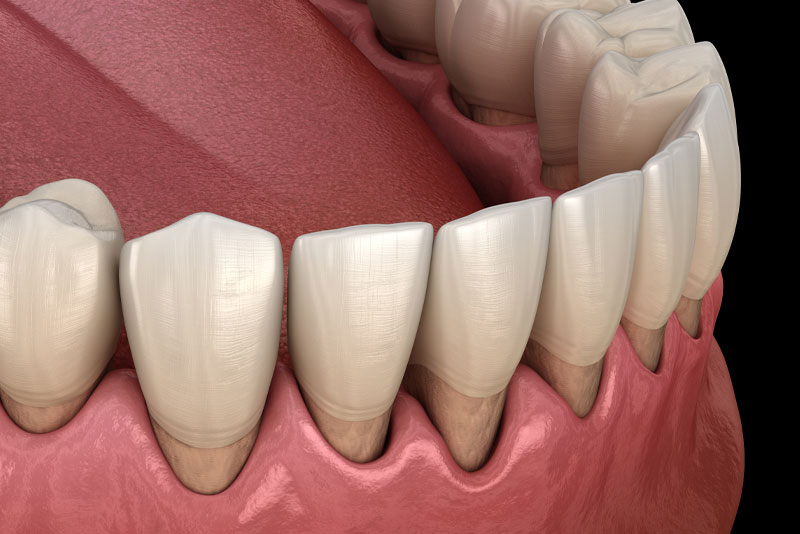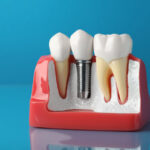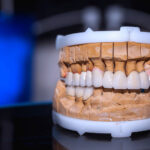If someone has sensitive teeth and has noticed their teeth appear longer, chances are they have gum recession. While gum tissue will never grow back on its own, Dr. Anderson can “reverse” gum recession with a unique surgical tunneling technique in Bloomfield Hills, MI.
Dr. Lauren Anderson, a board-certified periodontist, uses this minimally invasive technique as an alternative to traditional gingival grafting. In addition to earning her masters in soft tissue grafting techniques at the University of Michigan, Dr. Anderson remains ahead of the curve.
In 2019, she became certified as a S.M.A.R.T., a minimally invasive tissue grafting technique, provider at the University of Pennsylvania where she trained under its founder Dr. Ernesto Lee. This technique not only addresses cases of bone deformity but treats recession as it reinforces the structures that determine the position of the soft tissue.
Why Gum Recession Occurs
Gums can recede for a variety of reasons and due to its slow progression, many people don’t realize they even have this condition. Periodontal (gum) disease is the most common cause of receding gums, which is why it is important to seek treatment as soon as possible. Other factors that contribute to gum recession include:
- Aggressive tooth brushing
- Tooth grinding and clenching
- Poor dental health
- “Frenum” or muscle pulls
- Genetics
Patients may even discover that a number of these factors are working together to contribute to their gum recession in Bloomfield Hills, MI.
How The Tunneling Technique Treats Receding Gums
The tunneling technique is a multi-step process that takes advantage of the gum tissue that is already there to restore the function and appearance of gums. In addition to being very dependable, it is minimally invasive. Most patients require little to no “down time” after undergoing the tunneling technique.
What makes the tunneling technique so precise? When performed by a highly trained periodontist, the procedure resolves problems linked to thinning or receding gums. Essentially, tunneling allows for the threading of gingival (soft tissue), grafting material throughout tiny “tunnels” made in the gums.
Over time, the graft becomes part of the existing gum tissue. In fact, research shows that when performed correctly, the tunneling technique success rate for long-term tooth coverage hovers at the 100% mark. In other words, it’s an excellent choice as long as it is handled by a credentialed, experienced professional.
Understanding The Ins And Outs Of The Tunneling Technique In Greater Detail
Some people like to be able to picture what will happen before every type of dental treatment. Below are the steps patients can expect Dr. Anderson to take during the tunneling procedure to correct their current gum recession and prevent further receding of the gums.
First, Dr. Anderson cleans the surface of the teeth, including the exposed tooth roots and applies an etch to the roots (EDTA) to allow soft tissue ingress. Next, using a laparoscopic type technique, Dr. Anderson gently tunnels under the gum tissue with a specialized dental tool. The gum tissue between the teeth remains intact, while the tissue below will have a space for the new graft.
At this stage, Dr. Anderson inserts the tissue graft under the gum tissue to cover the exposed roots, making sure to optimize the aesthetic look of the tissue, as well. Finally, she sutures the graft in place so the treated site can heal.
Treating gum recession with this minimally invasive technique can improve a patient’s gum health, root sensitivity and smile appearance – most of all, it enhances the profile anatomically.
Reducing Further Risk Of Gum Recession After Tunneling
Wondering how you to reduce the chances of further gum recession? Some of the most effective ways to stop gum recession from recurring include:
- Stop smoking.
- Brush less aggressively.
- Floss less aggressively.
- Keep the teeth and gums clean.
- Stay up to date with dental cleaning appointments.
- Alert the periodontist to any early warning signs of gingivitis, like bleeding or red gums.
Is The Tunneling Technique Right For Everyone?
Like any dental procedure, the tunneling technique is more appropriate in some circumstances than it is in others. Who is a good candidate for the tunneling technique then? Although patients will want to get a periodontist’s opinion, the most common types of patients who respond well to tunneling tend to be those who present:
- Multiple instances of gum recession throughout the mouth.
- Enough gum tissue for Dr. Anderson to “tunnel” into the tissues.
Don’t worry if the tunneling technique is not the right fit, though. Dr. Anderson regularly performs other kinds of gum recession treatment procedures as well. This means patients will have options when it comes to establishing a healthier and fuller gum line.
Schedule Your Appointment To Talk About Gum Recession In Bloomfield Hills, MI
Do you need the tunneling technique in Bloomfield Hills, MI? Are you ready for specialized treatment? Get in contact with Dr. Lauren Anderson at our Anderson Periodontal Wellness office to schedule an appointment today!





